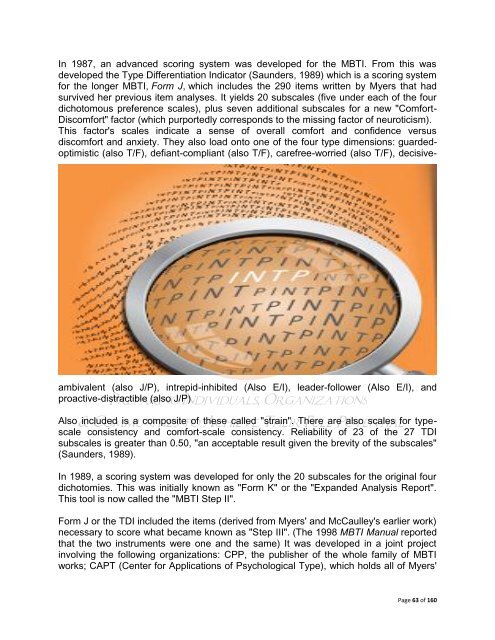The Gift of Introversion
The Gift of Introversion
The Gift of Introversion
You also want an ePaper? Increase the reach of your titles
YUMPU automatically turns print PDFs into web optimized ePapers that Google loves.
In 1987, an advanced scoring system was developed for the MBTI. From this was<br />
developed the Type Differentiation Indicator (Saunders, 1989) which is a scoring system<br />
for the longer MBTI, Form J, which includes the 290 items written by Myers that had<br />
survived her previous item analyses. It yields 20 subscales (five under each <strong>of</strong> the four<br />
dichotomous preference scales), plus seven additional subscales for a new "Comfort-<br />
Discomfort" factor (which purportedly corresponds to the missing factor <strong>of</strong> neuroticism).<br />
This factor's scales indicate a sense <strong>of</strong> overall comfort and confidence versus<br />
discomfort and anxiety. <strong>The</strong>y also load onto one <strong>of</strong> the four type dimensions: guardedoptimistic<br />
(also T/F), defiant-compliant (also T/F), carefree-worried (also T/F), decisiveambivalent<br />
(also J/P), intrepid-inhibited (Also E/I), leader-follower (Also E/I), and<br />
proactive-distractible (also J/P)<br />
Also included is a composite <strong>of</strong> these called "strain". <strong>The</strong>re are also scales for typescale<br />
consistency and comfort-scale consistency. Reliability <strong>of</strong> 23 <strong>of</strong> the 27 TDI<br />
subscales is greater than 0.50, "an acceptable result given the brevity <strong>of</strong> the subscales"<br />
(Saunders, 1989).<br />
In 1989, a scoring system was developed for only the 20 subscales for the original four<br />
dichotomies. This was initially known as "Form K" or the "Expanded Analysis Report".<br />
This tool is now called the "MBTI Step II".<br />
Form J or the TDI included the items (derived from Myers' and McCaulley's earlier work)<br />
necessary to score what became known as "Step III". (<strong>The</strong> 1998 MBTI Manual reported<br />
that the two instruments were one and the same) It was developed in a joint project<br />
involving the following organizations: CPP, the publisher <strong>of</strong> the whole family <strong>of</strong> MBTI<br />
works; CAPT (Center for Applications <strong>of</strong> Psychological Type), which holds all <strong>of</strong> Myers'<br />
Page 63 <strong>of</strong> 160

















